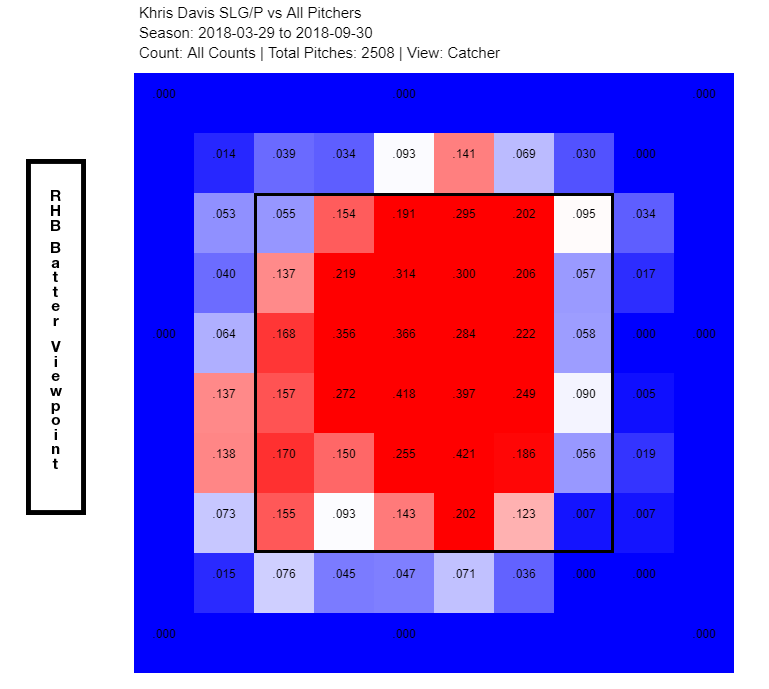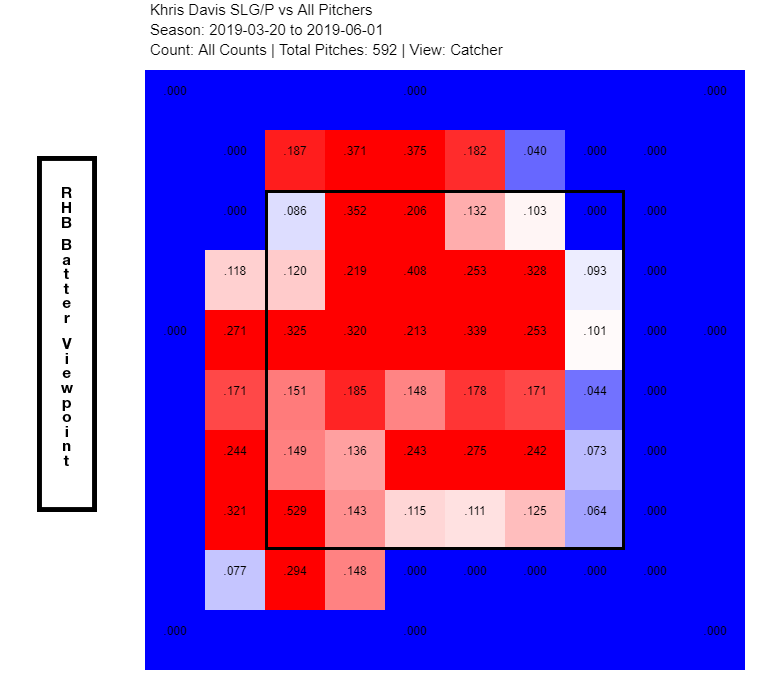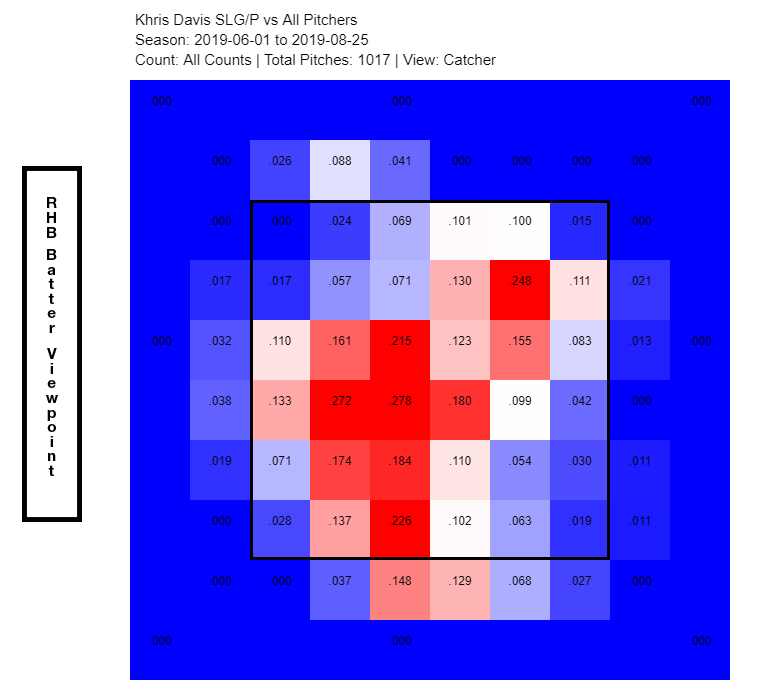Last week, as the Oakland Athletics were in the middle of sweeping the New York Yankees, Khris Davis did this:
This is a very aesthetically pleasing home run. Davis takes the outside pitch from J.A. Happ, puts a great swing on it and deposits it into right field to give the A’s the lead in what is a big series for them. That home run caused a lot of pressure to go away for Davis, as it snapped an 0-17 slide he had been on. This was also his first plate appearance following an o-fer in the series opener, where he earned a golden sombrero with four strikeouts. Following that performance, his season OPS dipped to it’s lowest point at .666. You wouldn’t expect it, but that home run was just the second Davis has hit in the second half of the season and the first since July 30th and only his 18th overall on the season. After leading the league with 48 home runs a season ago and 133 total in his first three seasons as an Athletic, there aren’t many who would have predicted a decline like this for Davis.
This season has been nothing short of a nightmare for him. Among qualified hitters, his -1.1 fWAR total is the worst by far with Miguel Cabrera being nearest to him with a -0.4 fWAR mark. As a primary designated hitter who adds near nothing defensively, you have to hit for more than a 74 wRC+. It also doesn’t look like this nightmare is ending any time soon, as Davis only has a 54 wRC+ since July 1 and a non-typo wRC+ of 38 in August.
Those familiar with Davis or the Athletics’ season would know that he has been injured this season. He injured his hip and groin in May and he dealt with a hand injury after being hit by a pitch back in June. He had a short stint on the injured list after trying to play through it for about two weeks, but it’s possible he still came back too early. I am pretty positive that those injuries have had an impact on his hitting performance since, and the effects of playing injured are part of what’s causing this long rough stretch.
The Athletics continue to play Davis on a nearly everyday basis, with the team allowing him to try and work through the issues. The team hasn’t suffered, as they’ve gotten strong performances from their core hitters Matt Chapman and Matt Olson, and getting breakout seasons from Marcus Semien and Mark Canha. Heck, even Robbie Grossman is getting hot, with a 113 wRC+ in August. As both the Athletics and Davis try to figure out how to reverse this trend, I think it’s relevant to point out that prior to going on the injured list on May 24, he was having a season that looked more like his usual self:
| AVG | OBP | SLG | HR | ISO | wOBA | wRC+ | |
|---|---|---|---|---|---|---|---|
| Pre-Injury | .248 | .318 | .497 | 12 | .252 | .334 | 110 |
Though it’s not quite what we would expect in terms of power or wRC+, he was still a productive hitter. He’s also just one tick off his usual .247 batting average. He went to the injured list on May 24 and he returned on June 1 (the injured list move was retroactive, hence why the stint was shorter than ten days), and since then it’s been all bad:
| AVG | OBP | SLG | HR | ISO | wOBA | wRC+ | |
|---|---|---|---|---|---|---|---|
| Post-Injury | .202 | .271 | .311 | 7 | .109 | .255 | 57 |
This is a prolonged rough stretch consisting of 256 plate appearances. Davis is experiencing a deep slump that he just can’t seem to break, caused I’m sure by the effects of injury, but the mental aspects shouldn’t be ignored either. As this slump continues, I’m sure it’s getting into his head and leading to doubt and frustration. This cycle may be something that only stops with some time off, whether it be by another injured list stint or the offseason. Perhaps some time off will do Davis well, as he would have an opportunity to reset and get healthy. I do think he will snap out of it. He’s been too good of a hitter in his career, but it just might not happen this season, which I’m sure is frustrating for his fantasy owners, his team and most importantly himself. What he does down the stretch will say a lot about how he is going to be valued going into 2020. A hot run to end the season will help ease a lot of doubts, but more of the same could cause a lot of damage going forward, both in terms of his fantasy value and how the A’s deal with his $33.5 million guaranteed through 2021. Hopefully things work out, as when Davis is on the top of his game, he’s one of the most fun players to watch. But for now, let’s take a closer look at this slump.
The first thing I wanted to look at was his plate discipline metrics. One of the reasons why slumps can extend for as long as this one has is by pushing too hard and trying to do too much when those bad results start to pile up. In Davis’ case, we do see some of that. Here’s a table showing his plate discipline prior to his return from the injured list compared to his plate discipline since coming back from the injured list:
| Time Frame | O-Swing% | Z-Swing% | Swing% | O-Contact% | Z-Contact% | SwStr% |
|---|---|---|---|---|---|---|
| Through 6/1 | 31.2 | 83.2 | 52.9 | 46.0 | 78.8 | 17.2 |
| Since | 29.5 | 84.7 | 52.3 | 43.6 | 74.6 | 18.6 |
While Davis is swinging at a similar rate during this split, he is swinging more at pitches inside the strike zone, but that isn’t actually leading to more contact on pitches in the zone, with a large decrease in zone-contact rate with a large increase in swinging strikes. While this wouldn’t be the worst thing in the world if Davis was still making solid contact, he hasn’t. Just looking at slugging on pitches in the zone: there’s not a whole lot of things to like. For reference, here’s how Davis slugged in 2018 and through June 1 of this season:


In 2018, Davis was an absolute masher on pitches in the zone and to start 2019, Davis took some steps back but was still solid, which matches up with his good-but-not-great 110 wRC+ through June 1. Since then, however, it hasn’t been pretty:

That’s an awful lot of blue, and the red isn’t even highlighting particularly strong numbers, with a .278 slugging towards the center of the plate as the high mark, which wouldn’t look overly impressive in his 2018 chart. He even had more impressive numbers in his pre-June chart.
So how do we get such a drastic decline in slugging? To start, I looked into his batted-ball profile. It became clear that July is where it looks like Davis has seen his batted-ball profile start to change:
| Time Frame | GB% | LD% | FB% |
|---|---|---|---|
| Through 6/30 | 39.7 | 22.3 | 38.0 |
| Since 7/1 | 46.2 | 19.4 | 34.4 |
A huge jump in ground balls since the start of July helps explain the slugging decline, as it’s difficult to hit for power when you put the ball on the ground. It’s worth noting that in his strong 2018 season, he hit fly balls nearly 50% of the time, so even those pre-July numbers are down significantly compared to 2018. Okay, so now that we know that he is hitting fewer fly balls, but when he is hitting fly balls, is he getting good results?
If you’re guessing the answer is no, you would be correct. Since we know that Davis only has two home runs since the second half of the season began, it’s a pretty good bet to guess that he isn’t hitting his fly balls with much authority. Like with his batted-ball profile, the issues really started to pop up during July. Since July 1, Davis’ fly balls have a slugging percentage of .190. Only Mallex Smith and Josh Reddick have been worse among hitters who have seen at least 500 pitches in that span. The average distance of those fly balls is 319 feet, which is towards the bottom of the league. He does have an xSLG of .425, perhaps a product of his 94.2 miles-per-hour average exit velocity, good enough to be ranked inside the top-50. While it looks a lot better than his actual slugging percentage of .190, we need to remember that a season ago, Davis slugged 1.372 on fly balls, and I should mention that prior to going on the injured list this season, he slugged a still-strong and similar 1.200 on fly balls. With results like that, it doesn’t look like having only two home runs in the second half is an accident.
The final area I wanted to look at was his batted balls by direction. While not an extreme pull hitter, Davis has usually gotten good results when he pulls the ball and pulls it in the air. As you might guess, he isn’t getting those same good results as of late. To show that, here’s a table comparing Davis’ slugging when pulling the ball:
| Time Frame | SLG |
|---|---|
| All 2018 | .752 |
| Through June 2019 | .809 |
| Since | .321 |
We see that before coming off the injured list in June, Davis was actually slugging better than he did in his great 2018 season when pulling the ball. Since then, it’s been the total opposite. This is not unlike what happened to Aaron Judge recently, who saw a similar decline in his results when pulling the ball after coming off the injured list when he was perhaps still feeling the effects of the injury. We’ve seen Judge snap out of his slump lately, and the pull-side power has returned with it, as Judge is presumably healthier now than he was when he first came off the injured list. As for Davis, the injuries could be affecting his ability to make strong pull-side contact in a similar fashion to Judge and it’s possible we can see that rebound from Davis too. Although it doesn’t look like it’s happened yet as I should note that Davis has only hit two fly balls to his pull-side since July and that the slugging percentage on pulled balls is significantly worse in August at .100. It doesn’t look like he’s figured it out yet, but it should be something to look at going forward, as if he gets this back under control, good results should come with it.
Without a doubt, this stretch by Khris Davis has been very brutal. While the A’s have been able to make up for the lost production, Davis has still been the equivalent of a black hole in the lineup, playing nearly every day with disastrous results. There would have been an interesting playing time decision to make with the return of Ramon Laureano looming, but with Stephen Piscotty landing on the injured list recently, it looks like Davis will remain in the lineup nearly every day going forward. Time is running out, with only a little over a month remaining in the season. Davis needs to play better if he wants to be a part of the starting lineup should they find themselves in a postseason series. By making some adjustments to his plate discipline along with improvements in his quality of contact, Davis would position himself to heat up during the final stretch and change the narrative of his season. Until then, each passing game with lackluster results is just another game in this long slump.
Featured Image by Justin Paradis (@freshmeatcomm on Twitter)


Great analysis and work! As a Davis owner the last 3 years, it feels like I’m rostering his evil twin brother since June lol. Appreciate the data to backup his struggles since injury. It will be interesting to see his auction price next preseason. Praying for a steep discount of his 2019 price and health of course!!
Thanks, glad you liked it! If you started him yesterday, you at least got a good game, which was cool to see. Hoping for more games like that to end the season.
Great article! Sad though. Hope he doesn’t duplicate his twin Chris. Debating picking him up as a potential keeper. He was dropped and his value goes to an 9th rounder if kept (12 team, 4 keeper league).